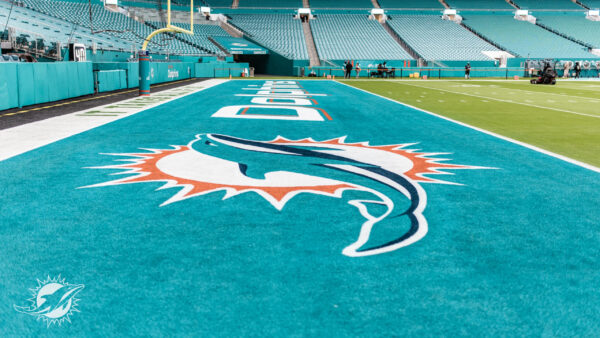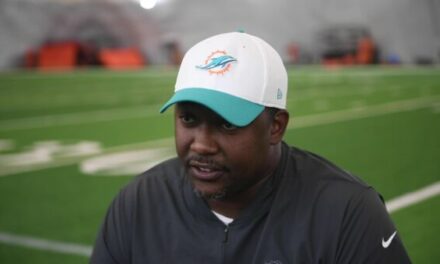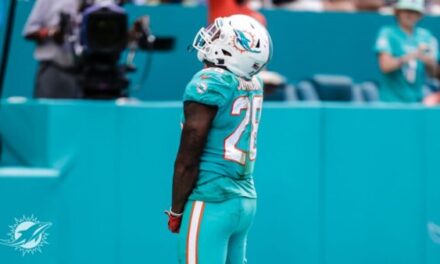Dalvin Cook’s decision to join the New York Jets has reverberated across the sports realm and resonated deeply with Miami Dolphins fans. As Cook’s path leads him to the Jets, a move rationalized by its on-field implications, it is essential to delve into the key drivers that shaped this choice and the larger ramifications it holds.
Logical Fit for the Jets
Beneath the surface of the captivating transfer drama lies a rationale that underpins Dalvin Cook’s choice to align with the New York Jets. Bolstered by their notable acquisition of Aaron Rodgers, the Jets have embarked on a resolute “all-in” strategy, transforming themselves into an appealing destination for Cook. The Jets’ calculated approach stems from their recognition of the need to bolster their running back corps, compounded by the uncertainty surrounding Breece Hall’s recovery from a debilitating torn ACL. Cook’s inclusion in their roster becomes a strategic maneuver to bridge this void and elevate their offensive dynamics. While the allure of representing his hometown Dolphins held its appeal, particularly given his past successes at Miami Central High, the Jets’ acute need and the opportunity for a pivotal role ultimately steered Cook’s compass towards New York.
Calculated Shift of Priorities
Delving deeper into this decision, Cook’s pivot to the Jets reflects the intricacies of team dynamics and strategic planning. The Jets’ eagerness to secure Cook’s services aligns with their recognition of his transformative potential, especially when coupled with Rodgers’ leadership. The confluence of factors – Rodgers’ addition, Hall’s injury-induced absence, and the immediate role Cook could play – collectively cements the Jets as an environment ripe for Cook’s talents to flourish. While hometown pride and the allure of an AFC East contender tantalized Cook within the realm of the Dolphins, it was the calculated approach of the Jets, offering a clear pathway to impact and integration, that cemented the narrative of Cook’s chapter in New York’s football saga.
Strategic Reflections of the Dolphins
Stepping into the Dolphins’ vantage point uncovers a calculated outlook that guided their stance on Dalvin Cook. Despite acknowledging Cook’s undeniable prowess as one of the NFL’s premier running backs, the Dolphins assessed him through a lens of necessity versus luxury. Anchored by a robust running back contingent consisting of Raheem Mostert, Jeff Wilson Jr., Myles Gaskin, and Salvon Ahmed, the Dolphins possess a wellspring of talent that lessens the immediate urgency for Cook’s inclusion. This constellation of capable runners, combined with the team’s penchant for a pass-focused offensive approach, hints at the potential limitations of Cook’s transformative impact within Miami’s scheme.
Balancing Priorities and Resources
The Dolphins’ strategic compass extends beyond the realm of running backs, entailing a broader focus on the multifaceted needs that define their roadmap. While Cook’s addition could undeniably infuse potency into their offensive arsenal, the Dolphins’ leadership faces the intricate challenge of resource allocation. With various positions demanding reinforcement and depth enhancements, the proposition of investing heavily in a marquee running back like Cook becomes a nuanced consideration. This underscores the Dolphins’ prioritization of bolstering areas that contribute to the team’s holistic competitiveness. By balancing their roster composition and aligning investments with strategic imperatives, the Dolphins have consciously navigated a path that emphasizes the collective over the singular, shaping the contours of their approach in the intricate tapestry of NFL dynamics.

Emergence of a New Powerhouse in the AFC East
The intricate web of fate has orchestrated Dalvin Cook’s union with the New York Jets. This move reconfigures the dynamics of the team alongside established talents like Aaron Rodgers and Breece Hall. This union creates a triumvirate of skill that augments the Jets’ potential as a formidable contender in the AFC East. The resultant transformation of the Jets into a forceful contender introduces an exhilarating challenge for both the Miami Dolphins and the reigning AFC East champions, the Buffalo Bills. The arrival of Cook not only reshapes the Jets’ trajectory but also amplifies the competitive stakes, escalating the pursuit for dominance within the division.
Narrative Infused with Intrigue
As Dalvin Cook prepares to don the Jets’ colors and confront his former rival, the Dolphins, a vivid narrative unfolds, brimming with strategic confrontations and emotional subtext. Cook’s prowess now operates as both a formidable opponent and a symbol of past accomplishments at the Hard Rock Stadium. His anticipated returns to the venue where he thrived during his Florida football journey inject a unique layer of intrigue into the unfolding drama of the NFL season. This renewed rivalry mirrors the broader tussle between franchises in their quest for supremacy, serving as a microcosm of the fierce competition that characterizes the league. As Cook’s chapter continues with the Jets, his presence promises to be a catalytic force, reshaping the landscape and narrative of the NFL’s unfolding spectacle.
Verdict
Dalvin Cook’s shift to the New York Jets reverberates as a nuanced narrative where strategic fit intertwines with calculated team priorities. Bolstered by the acquisition of Aaron Rodgers and a running back vacuum due to Breece Hall’s recovery, the Jets provided Cook with a clear path to impact, steering his compass towards New York despite hometown allure. Recognizing Cook’s prowess, the Dolphins viewed him as a luxury within their deep running back pool and pass-focused offense. This move not only reshapes AFC East dynamics but also sets the stage for a compelling saga where Cook’s returns to former venues infuse an intriguing personal touch into the evolving NFL drama, encapsulating the complexities of choices, strategies, and the ever-evolving storyline of the league.















We shall see if Cook can stay healthy, if he can be happy splitting duties with Breece Hall and Michael Carter. I sense tension in the locker room by mid season.